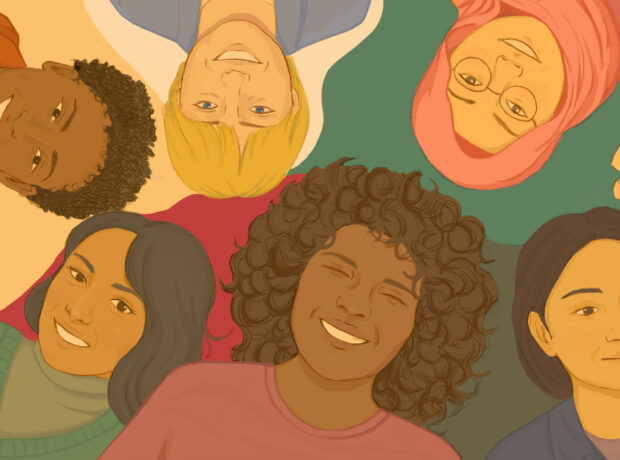A misunderstood practice of marriage between women is bringing an informal system of social welfare to communities in rural Kenya. Professor Ann Stewart shares the findings from her interviews of more than 100 “wives” in woman-to-woman marriages.
“I didn’t have children so my husband asked me to get another woman to marry so that I can have children.”
Beatrice and Florence sit side-by-side as they tell me about their marriage. The two women are from the Nandi community and live near Kapsabet in Western Kenya. Beatrice is 69, Florence 34. It isn’t an unusual relationship here.
“You know woman-to-woman marriages are part of our community,” says Beatrice.
These are customary non-sexual unions, where an older woman like her takes a younger woman as a wife. It’s a matter of protection. Beatrice explains why.
She already has a male husband but had no children with him. Without any sons or daughters, there would be no one to protect her when her husband died. That left her vulnerable, a position made even more precarious when her husband “married a second wife so that he could have children”.
Beatrice says once she passed menopause, she sought a younger woman to become her “wife”. Her husband encouraged her. “The decision wasn’t difficult to make,” she adds.
In traditional man-to-woman marriages, sons (usually drawing on family assets) provide “bridewealth” (similar to a dowry) – often in the form of livestock – to secure the marriage. Generally, each new daughter-in-law will, at some stage after the marriage, be provided with a home and a small plot to cultivate to provide food for her family.
It is no different in woman-to-woman marriages. Both families undertake the usual customary formalities to secure a recognised marriage so that the younger woman is accepted in the proper way into the family of the older woman (and her husband). Beatrice explains: “I knew this girl as she was a member of the community. I noticed that she was a good girl so one day I told her about my intention to marry her. She asked me to speak to her parents and I did that. The parents also agreed. “

Beatrice’s husband gave her the bridewealth to take to Florence’s place. A Kamba elder explains, “The man cannot give dowry for her directly because it would make her his wife, and he had already paid for his wife’s dowry. So it’s the woman who pays this dowry. So in this way, both the younger woman that is brought to the home, all the property in the house and the children born in this relationship belong to the older woman.”
It’s a mutually beneficial relationship. The older woman provides property and income. The younger looks after the household and cares for the older, aging partner as well as the children of this new family unit.
Beatrice says, “I have to provide for them. I pick tea and once I’m paid, I buy food for the family.” She pays the school fees and “takes charge of disciplining the children”. Florence is the homemaker – she cooks, cleans and works on the small family tea farm. But, Beatrice says, “We share responsibilities. Nobody feels like she is above the other. Woman/man marriages are full of squabbles and competitions between the man and the woman. The man would always want to show that he is the head and order the wife around, but for us we don’t have that.”
Florence already had a child when she married Beatrice and has had five more since. They explain with smiles that they have four boys and two girls.
Beatrice is a first wife. Her (male) husband “married a second wife so that he could have children”. Motherhood is central to social status and identity in most African communities, and sons are considered to be very important as the inheritors, particularly in rural communities where land matters both economically and socially. They inherit from their fathers to carry on the family line as well as to cultivate the land.
Beatrice adds that, when she dies Florence “will inherit all the land and divide it among her children as she wishes”.
Florence tells me that she chose the father of her children and that Beatrice “doesn’t know about him”. In the family unit, the biological father plays no role. The older woman becomes the socio-legal “father” of the children.
Does Florence care for her older partner? “Yes,” she says, she cares about her a lot. When we finish talking, Florence finds Beatrice’s stick and helps her up before they walk together to their home.

What Beatrice and Florence have is described in English and in the Kenyan law courts as a “woman-to-woman” marriage, although each community in Kenya has its own cultural understanding and name (nyumba mboke in Kuria, for instance).
These arrangements are thought to be common, mostly in Kenya’s rural western and central regions, and although there are no reliable statistics it is estimated that woman-to-woman partnerships make up 5-10% of marriages in Kenya. The practice can also be found in Nigeria, Tanzania and South Africa.
Without their woman-to-woman families, older women like Beatrice would have no one to protect them when their husbands die. Woman-to-woman marriage is recognised in their communities as a way of remedying that. Husbands (or their wider family after their deaths) are often involved in the decision-making process.
And because, through Florence, Beatrice now has sons, she will not lose her social status. She can expect her sons to help her economically as they grow older and her daughters-in-law to help care for her.
Florence, like all the younger women we talk to, already had a child before the marriage – out of wedlock. The union has secured this child’s future because all their children are treated as children of the marriage.
Both the younger woman and her children in the marriage are recognised as dependents within Kenya’s formal Succession Act and are therefore entitled to inherit. The arrangement provides ‘bequeathable’ assets to the younger woman in return for ‘wifely’ duties – providing children and care.

Agnes, 36, from the Kamba community, has been married to Patricia, 54, for six years. She had a son and daughter before marrying and has had another son since. Patricia, a business woman in Nairobi, provided five goats and a cow as bridewealth. Patricia, who still lives in the city, brings supplies such as food and clothes to Agnes and their children, while Agnes cares for their children and tends to the animals and the farm.
The male elders say these arrangements are very similar to a marriage between a woman and a man when it comes to the division of responsibilities between a breadwinner and a homemaker.
But couples we speak to, like Agnes and Patricia and Beatrice and Florence, don’t see it quite like the elders. They agree that, yes, the older woman takes on responsibilities for providing for the family financially and the younger woman takes on the traditional caring and cooking responsibilities of a rural wife. But each tells me in her own way that both wives “help each other to run the home.”
And as the older wife ages, the younger wife gradually takes on more duties.

One Kamba elder tells us: “Marriage is ordained by God so all marriages are acceptable to us.”
Another isn’t so sure: “God doesn’t allow these marriages. He recommends heterosexual marriages. However, these woman-to-woman marriages basically exist to perpetuate lineages. They are ok to this extent.”
A third agrees: “Woman-to-woman marriages help to raise homes that would otherwise disappear. For me they are good.”
A fourth adds: “Strictly speaking, woman-to-woman unions are not marriages as we understand marriages because there is no sexual relationship.”
Our interviews with women reveal mutual affection, in some instances keenly felt, which motivates the caring duties. But this, and the younger woman choosing her own sexual partner, of course, does not reduce the validity of women’s rights activists’ concerns over consent issues in woman-to-woman marriage, or the way it reinforces the value of women’s identity in terms of motherhood, particularly in bearing sons.
Beatrice and Florence and many of the other women living frugal lives in rural Kenya have found a way of supporting each other and their children as they pass through the various stages of life. Bearing in mind all the external constraints on their lives, they have found a way of making this arrangement work for them – for the present. The future is another matter.
Artwork by Beatrice Florence Taylor
Read more about this story:



